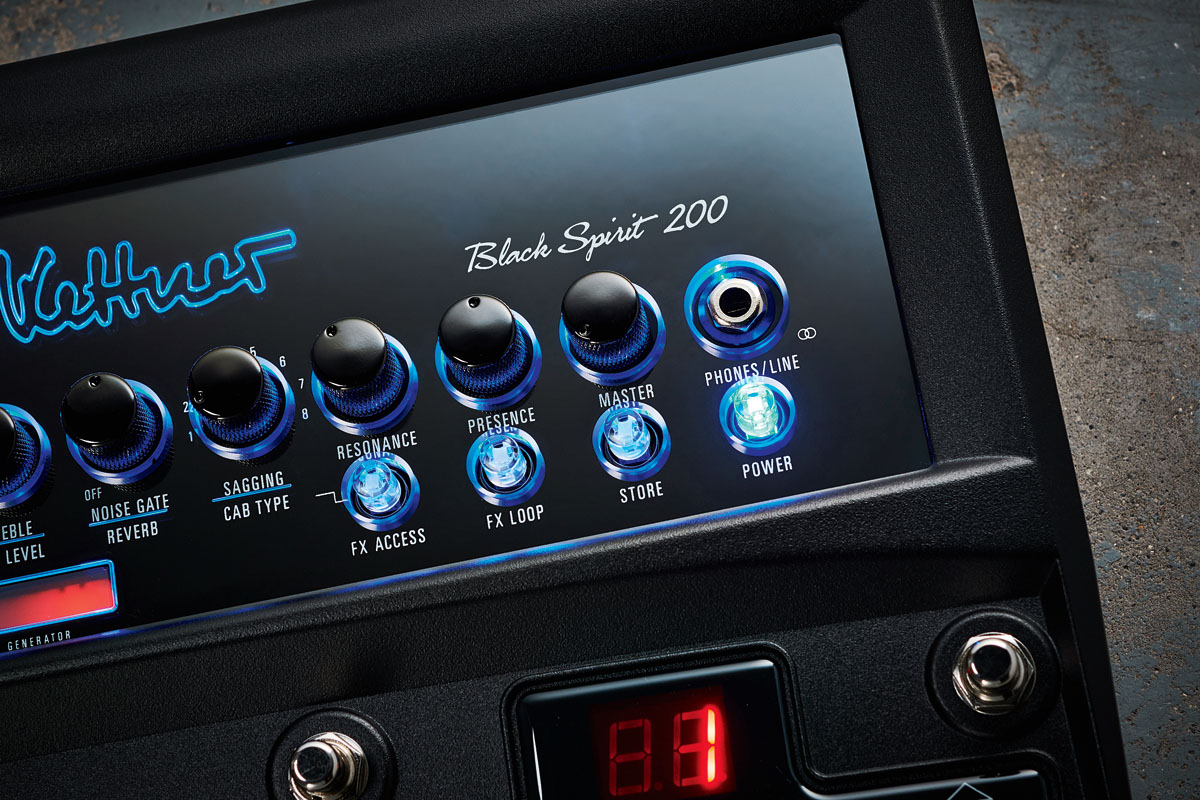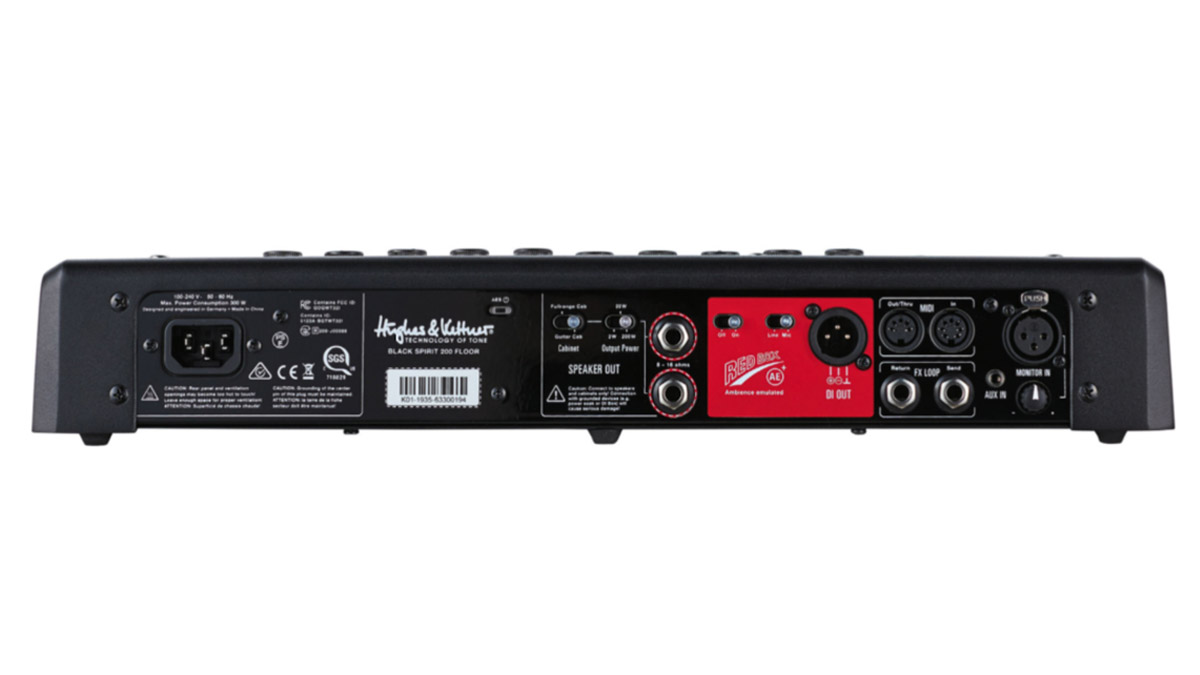Guitar World Verdict
For working players who are looking for a credible alternative to valves, Hughes & Kettner’s Black Spirit 200 Floor is a pretty compelling choice - what’s not to like?
Pros
- +
Great looks.
- +
Tough, ultra-lightweight casing.
- +
Huge versatility and superb tone.
- +
The sag control adds real valve-like dynamics.
Cons
- -
Remote app support needs attention.
- -
The standalone FS-432’s DC power outlet is missing.
You can trust Guitar World
Hughes & Kettner’s hugely successful TubeMeister range was topped a couple of years ago with the GrandMeister Deluxe 40 head, which added full digital control together with built-in effects and more.
At the time, we wondered if there was anywhere left to go, but we weren’t kept waiting for long before Hughes & Kettner introduced the Black Spirit 200 head, essentially a rework of the valve-powered GrandMeister Deluxe on a solid-state platform.
The Black Spirit 200 brought stunning analogue tone from Hughes & Kettner’s breakthrough Spirit Tone Generator circuit, not to mention greater portability and consistent night-after-night performance.
Now Hughes & Kettner has added a new floor version that combines the head with an integrated FSM-432 MIDI controller, and called it, unsurprisingly, the Black Spirit 200 Floor.
Because of its similarity to other modelers and multi-effects floor boards, it’s important to point out the Black Spirit 200 Floor is neither of these things. It has a digitally controlled analogue solid-state preamp that Hughes & Kettner calls the Bionic Spirit Tone Generator, featuring four channels - Clean, Crunch, Lead and Ultra.
This preamp is teamed with high-quality onboard digital effects and a Class D output stage producing a whopping 200 watts into a pair of speaker outlets, with switchable attenuation down to 20 and two watts.
H&K’s Floor condenses amps, flight cases, cables and pedals into a chocolate box-sized package you can lift with one finger
There’s also an integrated Red Box cabinet simulator with eight selectable cabinet types, two pre effects loops that sit in front of the main preamp signal shaping, and one regular series effects loop.
All the latest guitar news, interviews, lessons, reviews, deals and more, direct to your inbox!
Bluetooth lets you stream audio to the Black Spirit and control everything remotely from a mobile app, with 128 slots to save things to.
Foot control comes from an integrated version of H&K’s FSM-432 MkIII MIDI board, which has seven button switches and operates in three different modes: Preset mode lets you access all 128 patches in 32 banks of four, ideal for Top 40 players who can put a song in each bank; Stompbox mode uses each button to access channels, boost and effects; and a new Direct 7 mode lets you assign a favorite patch to each button for instant recall.
The black painted die-cast aluminum housing feels substantially tough; it’s very portable but heavy enough to stay where it’s put. Hughes & Kettner’s trademark blue backlighting surrounds all the controls, which are much easier to use than they may appear at first glance.
The channel selector decides the basic voice setting, followed by conventional gain, volume and EQ controls. A programmable boost option - configured differently for each channel - adds extra gain and dynamics. There’s an intelligent dual breakpoint noise gate and the Black Spirit’s innovative sag control, which emulates the squashy dynamics of a valve power amp being driven hard, in eight progressive stages.

Pressing the FX Access button puts the amp controls into effects editing mode, with a choice of chorus, flanger, phaser or tremolo combined with delay and reverb, while the sag control changes to access the Red Box’s different cabinet emulations.
Finally, there are master controls for presence and resonance, together with a global master volume. Presence and resonance can be configured to act either as global EQs or with their position saved as part of a patch; the master volume is the only non-programmable control.
Other features include a cabinet EQ switch that provides a flat sound for regular guitar cabs, or Red Box emulation for passive full-range speakers. There's also a headphones/line out, full MIDI and a monitor/aux input with its own level control.
While the Black Spirit 200 Floor isn’t a modeling amplifier, its core tones are deep and wide enough to cover practically every musical genre, from country and jazz to thrash metal
The Bluetooth remote app essentially mirrors the real controls and doesn’t unlock any hidden functions. It currently works on iPads and Android tablets but not iPhones, which is something we think H&K really needs to address, especially as iOS is being split into two versions. Another annoyance is the lack of a DC outlet to power stompboxes.
You’ll find one on the standard FSM-432 foot controller, but here, with three loops conveniently on the floor right where your pedals would be, there’s no power for them.

Sounds
While the Black Spirit 200 Floor isn’t a modeling amplifier, its core tones are deep and wide enough to cover practically every musical genre, from country and jazz to thrash metal. The Clean channel’s EQ can make it fat and tweedy, with a touch of slapback delay for great rockabilly stuff, or you can scoop out some of the mids for a more contemporary shimmer topped off with a dash of chorus.
The Crunch channel ups the gain for great classic rock and blues styles, with the Lead channel adding more gain and attack, while the Ultra channel is where you’ll find all the compressed, liquid sustain tones favored by many modern rock players.
The quality of the overdrives is superb. Hughes & Kettner has always been among the best when it comes to solid-state amps, going right back to the Attax series from two decades ago. Since then things have moved on in leaps and bounds. The crucial lower gain nearly clean tones come alive when tweaked with the sag control, adding tactile and responsive dynamics that flatter each guitar’s character.

The Black Spirit’s onboard effects are very usable. It’s the same chorus/flange/ phaser/tremolo combination you’ll find on most of the competition - so no real surprises. Nevertheless, they’re decent quality and, of course, there are three separately programmable loops for your favorite stompboxes as well.
The Red Box offers eight different cab simulations with a proper balanced output, adding great flexibility for connecting to live or recording consoles. Now in its fifth generation, the standalone Red Box is a de facto standard for direct recording and many working players have one in their gigbag.
Adding this feature to the Black Spirit 200 greatly increases its usefulness for stage and studio, saving setup time and improving separation.
Verdict
Valves or tubes are used in most classic guitar amps from the 1950s to the present day, so they’re usually behind the great tones that we’ve come to love. However, current mass-produced valves aren’t as reliable or consistent as their 50s counterparts, making it increasingly difficult and expensive to keep a valve amp running in peak condition.
Digital modeling continues to advance along its own path. Meanwhile, we think the Black Spirit 200 range has truly raised the bar for solid-state tone, combining fat analogue sounds with modern Class D output stages to achieve portable power that would have been unthinkable just a few years ago.
The new Floor version here adds most of the functionality of the head version, plus the FSM-432 MIDI controller, with a few cool extras at a modest saving, making it great value for money.
Hughes & Kettner’s Black Spirit 200 Floor condenses all of that and more into a chocolate box-sized package you can lift with one finger
Back in the 1970s, the standard rig for many pro touring guitarists would have been a 100-watt British head and 4x12, plus a 100-watt American or Japanese 2x12 combo for clean sounds, together with flight cases, cables and pedals. Hughes & Kettner’s Black Spirit 200 Floor condenses all of that and more into a chocolate box-sized package you can lift with one finger, not to mention the sort of reliability and night-after-night consistency that most valve competitors can’t match.
For working players who are looking for a credible alternative to valves, Hughes & Kettner’s Black Spirit 200 Floor is a pretty compelling choice - what’s not to like?
Specs
- PRICE: $1,199, £899
- ORIGIN: China
- TYPE: Analogue solid-state preamp with fully programmable digital control and effects, Class D power amp
- OUTPUT: 200W (switchable to 20W and 2W)
- VALVES: None
- DIMENSIONS: 70 (h) x 470 (w) x 255mm (d)
- WEIGHT (kg/lb): 4/9
- HOUSING: Die-cast aluminium
- CHANNELS: 4 selectable voices, with programmable boost
- CONTROLS: Channel select, gain, volume, bass, mid and treble. Noise gate, sagging, resonance, presence, master volume. Pre loop select x2, boost select, fx access, loop select, store preset, monitor in level, cab type select, output power select, Red Box on/off, line/mic select, foot controller mode select, MIDI in, out/thru
- FOOTSWITCH: Integrated FSM-432 MkIII 7-button MIDI controller with 3 modes: Preset, Stompbox or Direct 7
- ADDITIONAL FEATURES: Integral digital effects (modulation/delay/ reverb), noise gate, sagging control, integral Red Box with eight cabinet types, 2 ‘pre’ effects loops, 1 series effects loop, balanced monitor input with level mix, headphones/line out, aux in. Bluetooth audio streaming and remote control via app
- OPTIONS: Padded carry bag (£59)
- RANGE OPTIONS: The head version is $999/£769, with a separate FSM-432 MIDI foot controller at $219/£159. The Black Spirit 200 1x12” combo with special ported cabinet is $1,439/£1,299
For more information, head to Hughes & Kettner.
Nick Guppy was Guitarist magazine's amp guru for over 20 years. He built his first valve amplifier at the age of 12 and bought, sold and restored many more, with a particular interest in Vox, Selmer, Orange and tweed-era Fenders, alongside Riveras and Mark Series Boogies. When wielding a guitar instead of soldering iron, he enjoyed a diverse musical career playing all over the UK, including occasional stints with theatre groups, orchestras and big bands as well as power trios and tributes. He passed away suddenly in April 2024, leaving a legacy of amplifier wisdom behind him.


